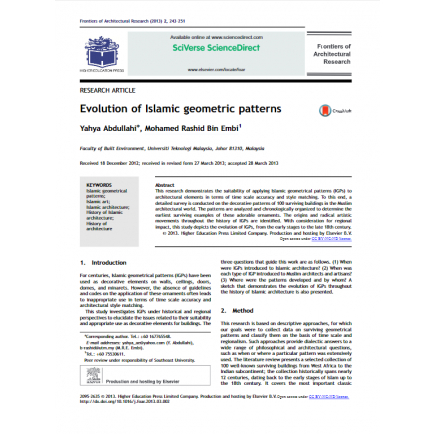
Evolution of Islamic geometric patterns
Date Added
25/07/2019
Content Type
Documentary
Category
Researches
Link to Content
Subject Area
Interior Design - Islamic Pattern
Author
Yahya Abdullahi and Mohamed Rashid Bin Embi
Publisher Name
Elsevier B.V.
Year of Publication
2013
1. Introduction 2. Method 3. When and how did geometry penetrateIslamic architecture? 4. Types of Islamic geometrical patterns 4.1. Umayyad architecture (660–750 CE) 4.2. Abbasids architecture (750–1258 CE) 4.3. Fatimid's architecture (909–1171 CE) 4.4. Seljuk architecture (1038–1194 CE):firstartistic movement 4.5. Mamluk architecture (1250–1517 CE): secondartistic movement 4.6. Ottoman architecture (1290–1923 CE) 4.7. Safavid architecture (1501–1736 CE) 4.8. Mughal architecture (1526–1737 CE) 4.9. Muslims of Spain 5. Conclusion 5.1. Scientific progress
Description
This research demonstrates the suitability of applying Islamic geometrical patterns (IGPs) to architectural elements in terms of time scale accuracy and style matching. To this end, a detailed survey is conducted on the decorative patterns of 100 surviving buildings in the Muslim architectural world.
The patterns are analyzed and chronologically organized to determine the earliest surviving examples of these adorable ornaments. The origins and radical artistic movements throughout the history of IGPs are identified. With consideration for regional impact, this study depicts the evolution of IGPs, from the early stages to the late 18th century.





